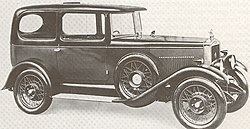| MG 14/40 | |
|---|---|
 1929 Tourer Mark IV | |
| Overview | |
| Manufacturer | MG |
| Production | 1927–1929 |
| Assembly | United Kingdom: Cowley, Oxford, England |
| Body and chassis | |
| Class | Sports car |
| Body style | 2-door, 2 and 4 seater open tourer 2 door coupé (Salonette) 4-door saloon [1] |
| Powertrain | |
| Engine | 1802 cc four cylinder, side valve |
| Transmission | three speed manual |
| Dimensions | |
| Wheelbase | 106 inches (2705 mm) [1] |
| Length | 150 inches (3810 mm) [1] |
| Chronology | |
| Predecessor | MG 14/28 |
| Successor | MG 18/80 |
The MG 14/40 or MG 14/40 Mark IV is a sports car that was made by MG and launched in 1927. It was based on the contemporary Morris Oxford flatnose and was a development of the MG 14/28 and was built at Edmund Road, Cowley, Oxford where MG had moved in September 1927. [1] During production it became the first model to carry an MG Octagon badge on its radiator, the previous cars had retained a Morris Oxford badge. [2]
The change of name from 14/28 to 14/40 seems mainly to have been a marketing exercise and the reason for the Mark IV is unclear although it has been suggested that it represented the fourth year of production. [3] Externally the cars are very difficult to tell apart.
There were some changes to the 14/28 chassis and suspension and the brake servo was deleted. [3] Production ended in 1929, after approximately 700 cars had been built. [2]
- 1927 Four-seater sedan
- 1928 Open two seater Mark IV

